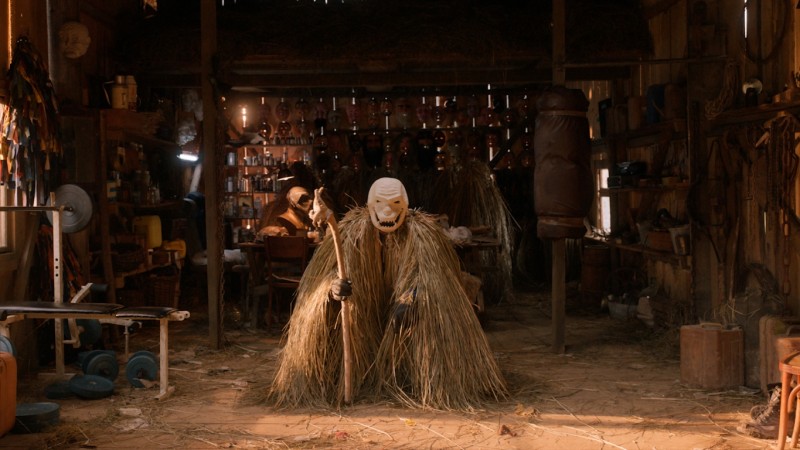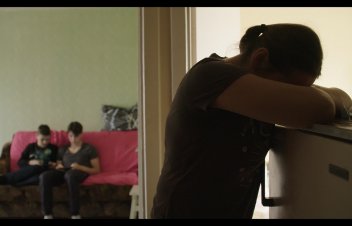
What’s happening now with Ukrainian cinema is a paradox. On the one hand, new Ukrainian films are premiering at the world’s biggest film festivals and major foundations are supporting projects by Ukrainian filmmakers and producers, some of which frequently hit the news in trade outlets. The reputation of Ukraine’s president as an ex-producer and an actor (perhaps now playing the most prominent role of his life) provokes the question: does his background help the Ukrainian film industry?
The answer is: no. At home, most Ukrainian filmmakers – those who have been walking on red carpets and combining promotional campaigns for their films with telling people about the genocidal Russian war against their country – have since early 2020 met with a complete absence of crisis management and governing of the sphere.
Why has this happened, what was before, and what will be next?
A bit of political context
Before the full-scale Russian invasion, and before the COVID-19 pandemic, which significantly influenced the global film industry, there were presidential and parliamentary elections in Ukraine. President Petro Poroshenko, elected right after the Maidan Revolution of 2013–2014, lost to Volodymyr Zelensky. The latter gained almost a monopoly of power; along with the presidential office, his “Servant of the People” party – named after a popular TV series (streaming on Netflix) – won the majority of seats in the Ukrainian parliament. After that, television people were everywhere:
one TV producer replaced another in the Minister of Culture chair; co-owners, producers and screenwriters of Kvartal 95, the production company that brought Zelensky to prominence, became MPs and got top positions in the President’s Office.
The current head of the President’s Office is not connected with Kvartal but was connected with the film industry. Before his political career miraculously took off with the position of the president’s advisor, Andriy Yermak produced several movies: the sports action film The Fight Rules (2017), the Slovakian-Ukrainian co-production The Line (2017), the romantic comedy Skvot32 (2019) and the drama Forebodings (2020). Among these, the most successful was The Line, which even received a prize in Karlovy Vary. However, it had a rough time in Ukrainian cinemas; Yermak even blamed the distributor for the low box office earnings.
While working in the industry, Yermak established several companies that were eligible to apply for state funding. When he became the head of the President’s Office in February 2020, he gave these companies up to partners; one of them, Artem Kolubaev, is the head of the Council for State Support of Cinema. This Council is the main body that decides which projects or events are to receive state funding, when they should be finished, and whether they are accepted by the main sponsor, the Ukrainian State Film Agency. The board’s composition changed in 2021, and their term formally ended in 2023, but no one is going to quit. Because of the martial law in Ukraine, the government is tackling the issue of the election of new directors or decision-making bodies at its will. Some competitions take place, some do not.
And so, Kolubaev stays. His companies even receive state support for their films, support that has been uneven and unstable since 2020. The companies of other members of the Council also don’t remain without taxpayers’ money: they don’t vote for their own projects, but they vote for the projects of others. Thus, a very exclusive and cronyistic system has evolved.
In 2020, the State Film Agency also got a new head, appointed as a result of a competition that took place twice. The first time, the government was unhappy with the possible win of Julia Sinkevych, a producer and ex-director of the Odesa Film Festival, which is supported by many Ukrainian filmmakers. The eventual winner was Marina Kuderchuk, a former tax inspector and local state clerk who worked with environmental issues and – at the time of her appointment – was the head of a municipal cinema in Zaporizhia. Although she did not have a formal connection with Yermak, she was immediately tied to him, because, according to the claims of some producers and filmmakers, he wanted to establish full control over the state governing and funding of Ukrainian cinema.
How was Ukrainian cinema governed before?
The state has always played a crucial role in supporting cinema in Ukraine, and the State Film Agency has a monopoly in funding it; few films are privately financed in Ukraine, and most of those are low-budget films.
After 2014, the amount of state funding poured into cultural projects, including cinema, increased, and the need for cultural policies appeared.
Thus, for instance, in 2020, Ukrainian cinema received 16.5 million US dollars per year, which is a lot for a rising industry and enough to fund up to 100 different film projects and events. First feature films were able to receive 100% state funding (with 100% ownership of rights by the state, too), while other projects could receive 30% to 80% of their budget in state funding. Ukrainian producers began participating in co-productions and became integral to the international film market.
In 2019, there were months when there was a fresh domestic premiere every week, which was an unprecedented event for Ukrainian cinema of the independence period. Ukrainian films were selected at big film festivals and bought for international markets. We debated whether we could call this a “new Ukrainian wave” or perhaps invent another term for a mixed generation of filmmakers of different ages and with various different artistic pursuits and focuses. Some of them got the opportunity to debut in their late 30s (Myroslav Slabospitskiy started filming his famous The Tribe when he was 39); some of them came back home after debuting in the 1990s but then witnessing the collapse of the industry and leaving the country; some dived into documentary filmmaking, reflecting the reality of post-Maidan changes, the occupation of Crimea and the war in the eastern regions of Ukraine that Russia began waging in 2014. A multifaceted Ukrainian cinema emerged while the state was willing to support various projects, not all of which served patriotic purposes (although there were attempts to turn the system of state pitchings into a system of state commissioning).
In 2015, Ukrainian TV managers and producers, whose companies were drained after they stopped collaborating with Russia in 2014, were also eager to start receiving state funding. So, together with filmmakers and the State Film Agency (then headed by Philip Illienko, the son of renowned director and cinematographer Yuriy Illienko), they co-established the initiative to change Ukrainian legislation in the field, which was, in their opinion, mainly old-school and provided too many regulations.
The new law, adopted in 2017, introduced the creation of the above-mentioned Council for State Support of Cinema, a cash rebate system, and opportunities for TV productions and series projects to join the competition for state money. The latter, as everyone later understood, was a priority.
Meanwhile, strategic issues such as allowing the Agency to fund the development stage of projects, clarifying the status of the state film archive tasked with preserving copies of films, and developing a network of cinemas across the country (as of August 2021, Ukraine had only 623 screens, and this number has decreased dramatically since the start of the full-scale invasion) were not on the table. And still aren’t.
A complete misunderstanding of the industry’s needs and a lack of strategic vision are the main points for which the State Film Agency is being criticized.
Even when state money was needed elsewhere – in 2020 in the healthcare system, and in 2022 in the Ministry of Defense – the Agency could have done the necessary legislation work to make the lives of Ukrainian filmmakers easier. Instead, it worsened them, lowering the transparency of procedures, tightening the regulations and audits that stymie producers, demanding loyalty and developing an intolerance to criticism. Even when the government renewed the funding of Ukrainian cinema, the costs were accompanied by many questions regarding the possible conflict of interest among the members of the Council.
The situation remains unchanged in 2023. According to a poll conducted by the Ukrainian Film Academy of its 101 members, 81.2% of respondents think that the state of the Ukrainian film industry has declined since January 2020, and 79.2% negatively evaluate the work of the current head of the Ukrainian State Film Agency. The respondents emphasize the lack of communication from the Agency, the absence of crisis management during the COVID-19 pandemic and then full-scale war, and the opacity of the work of the Council.
What will happen next?
If the situation described above had arisen two years earlier, Ukraine would not have so many new films to present since Russia began its full-scale war against Ukraine. In 2022, the presence of Ukrainian culture on international platforms, at festivals, and in markets was essential, adding to the state’s diplomacy and making diverse Ukrainian voices and stories visible to the world.
2022 saw the premiere of Klondike at Sundance amid active discussion about the possible Russian offensive, Boney Piles at the 72nd Berlinale, Pamfir and Butterfly Vision in Cannes, How Is Katya? in Locarno and Luxembourg, Luxembourg in Venice.
Many more new and old Ukrainian film screenings were held at other film festivals worldwide. But this may have been the last major wave of Ukraine’s presence at film festivals focusing on fiction films. This year’s La Palisiada and Do You Love Me? (which already had their world premieres) as well as Stepne and When We Were 15 (which might have their festival releases later this year), joined by Demons and Editorial Office in 2024, may be the last examples of the “Ukrainian new wave” in the nearest future.
Despite the huge and deeply appreciated support for Ukrainian cinema from international foundations and initiatives aimed at developing new projects and completing those near the finishing line, support is still needed for the production stage.
Here, only the documentaries will be left alive, as their production can be cheaper and thus more independent.
Fiction films and animation rely on sustainable and strategic support as well as adequate state policies. None of that is present in the current Ukrainian film ecosystem.
What remains is the enormous power of professional communities fighting for their rights in courts, offline film festivals as gatherings of solidarity and connection for various social bubbles, and the unshakable faith in culture as a necessary tool to build a better society. Ukrainians are not easily satisfied by the films, books, or artwork produced only elsewhere. They are eager to look into the many mirrors that Ukrainian arts can provide, with no full-scale war stopping them. And they have already started asking their government many unpleasant questions.
P.S.: Ukraine’s President Volodymyr Zelensky has his own questions regarding the government, and therefore recently he asked the prime minister to find a replacement for the current minister of culture. In response, Minister of Culture Oleksandr Tkachenko, the former general producer of the 1+1 television channel (one of the most influential in the country and also where Zelensky flourished with his late-night standup show), resigned from his position. The resignation, however, was not initially supported by the parliamentary committee, forcing the Ukrainian parliament to make a decision, which it did on July 27, accepting Tkachenko's resignation.
It must be mentioned that Tkachenko had tried to resign once before, when the Cabinet of Ministers (but in fact, the Office of the President) decided to change the order of submission in Ukrainian culture and brought the State Film Agency out from under the Ministry’s responsibility directly to a governmental one, providing absolute autonomy for the Agency. His resignation was not supported then.
Not so long ago, in an effort to take back a piece of the filmmaking-related pie, the Minister of Culture launched a competition for “patriotic” television series projects. Overall, the Ministry was going to spend UAH 448 million (almost EUR 11 million) on television content related to an “artistic rethinking of today’s reality, the history of the war, and the resilience and heroism of Ukrainians”. The competition’s results led to a huge scandal amidst Ukraine’s counteroffensive against the Russian invasion and a discussion about what public money should be spent on during the war.
While the discussion is ongoing, and the reputation of the Ministry of Culture and its initiatives really harmed, Ukrainian filmmakers are continuing to present themselves at film festivals and professional programs and to fight for transparency in the country’s decision-making in the cultural field. For now, Ukrainian cultural policy is obscure as is the future of Ukraine’s filmmaking.

















